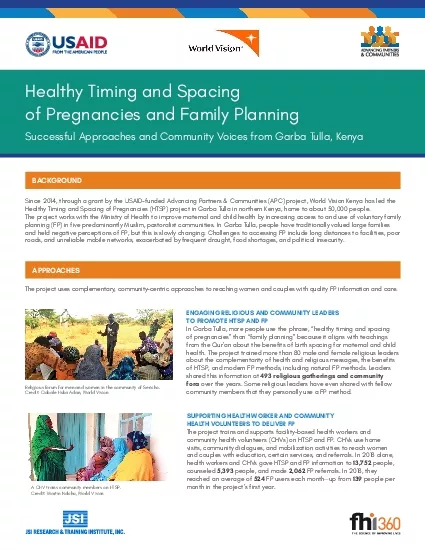

Healthy Timing and Spacing of Pregnancies HTSP project in Garba Tulla in northern Kenya home to about 50000 people The project works with the Ministry of Health to improve maternal and child health by ID: 858488
Download Pdf The PPT/PDF document "Since 2014 through a grant by the USAIDf..." is the property of its rightful owner. Permission is granted to download and print the materials on this web site for personal, non-commercial use only, and to display it on your personal computer provided you do not modify the materials and that you retain all copyright notices contained in the materials. By downloading content from our website, you accept the terms of this agreement.
1 Since 2014, through a grant by the USAID
Since 2014, through a grant by the USAID-funded Advancing Partners & Communities (APC) project, World Vision Kenya has led the Healthy Timing and Spacing of Pregnancies (HTSP) project in Garba Tulla in northern Kenya, home to about 50,000 people. The project works with the Ministry of Health to improve maternal and child health by increasing access to and use of voluntar planning (FP) in five predominantly Muslim, pastoralist communities. In Garba Tulla, people have traditionally valued large families and held negative perceptions of FP, but this is slowly changing. Challenges to accessing FP include long distances to faciliti roads, and unreliable mobile networks, exacerbated by frequent drought, food shortages, and political insecurity. The project uses complementary, community-centric approaches to reaching women and couples with quality FP information and care ENGAGING RELIGIOUS AND COMMUNITY LEADERS TO PROMOTE HTSP AND FP In Garba Tulla, more people use the phrase, “healthy timing and spacing of pregnancies” than “family planning” because it aligns with teachings from the Qur’an about the benefits of birth spacing for maternal and child health. The project trained more than 80 male and female religious leaders about the complementarity of health and religious messages, the benefits of HTSP, and modern FP methods, including natural FP methods. Leaders shared this information at 493 religious gatherings and community fora over the years. Some religious leaders have even shared with fellow community members that they personally use a F
2 P method. SUPPORTING HEALTH WORKER AND
P method. SUPPORTING HEALTH WORKER AND COMMUNITY HEALTH VOLUNTEERS TO DELIVER FP The project trains and supports facility-based health workers and community health volunteers (CHVs) on HTSP and FP. CHVs use home visits, community dialogues, and mobilization activities to reach women and couples with education, certain services, and referrals. In 2018 alone, health workers and CHVs gave HTSP and FP information to 13,752 people, counseled 5,393 people, and made 2,062 FP referrals. In 2018, they reached an average of 524 FP users each month—up from 139 people per month in the project’s first year. Healthy Timing and Spacing of Pregnancies and Family Planning Successful Approaches and Community Voices from Garba Tulla, Kenya Religious forum for men and women in the community of Sericho. Credit: Qabale Huka Adan, World Vision A CHV trains community members on HTSP. Credit: Martin Ndichu / World Vision BACKGROUND APPROACHES INVOLVING MEN IN THE CONVERSATION Because men are important in household decision-making, the project engaged them to be supportive partners for HTSP through male-only dialogues and other community activities. Men learned more about the importance of FP and how to help their wives stay healthy, such as by accompanying them for health facility visits. At each facility, the project introduced male-friendly corners where men can hear more about health topics from CHVs and other facility staff while they wait for their wives. STRENGTHENING WOMEN’S PARTICIPATION IN HEALTH AND DEVELOPMENT World Vision also supports a mothe
3 r-to-mother savings group in each commu
r-to-mother savings group in each community that meets monthly to discuss priority community issues. These groups provide an opportunity for women to learn more about HTSP, FP and health; participate in a group savings scheme; and develop skills for conducting income-generating activities, such as gardening, poultry farming, tailoring, and craft-making. INTEGRATING HTSP AND FP INTO MATERNAL AND CHILD HEALTH SERVICES At the facility level, the project incorporates HTSP and FP information and care as part of routine maternal and child health services, such as postpartum care and immunization. Over the course of the project, 13,480 women and men received voluntary, integrated FP care. IMPROVING HEALTH SERVICE ACCOUNTABILITY To cultivate civic engagement in health and development, World Vision involves the Garba Tulla communities in a process called Citizen Voice and Action (CVA), which trains and engages community members, health workers, and county officials on social accountability, advocacy, and action planning to prioritize and monitor activities to improve their communities. This strategy led to a range of improvements, such as upgrading health facility infrastructure. Male CHVs have been crucial to reducing stigma around family planning by reaching out to other men. Credit: Kristen Devlin / JSI A mother-to-mother savings group makes brooms. Credit: Qabale Huka Adan, World Vision During an immunization visit for their new baby, this couple received FP counseling, and selected to use an implant to space their next birth. Credit: Kristen Devlin / JSI